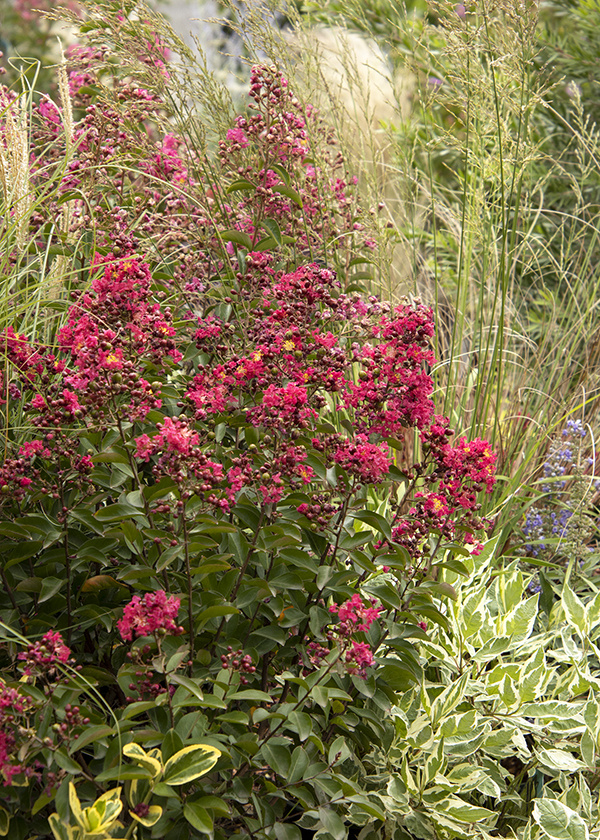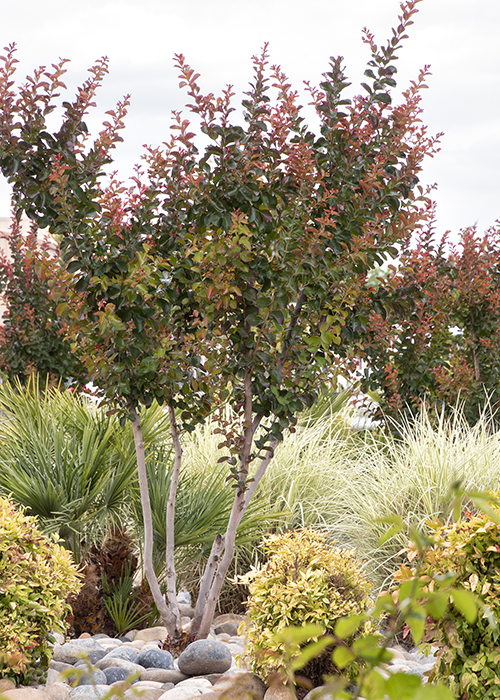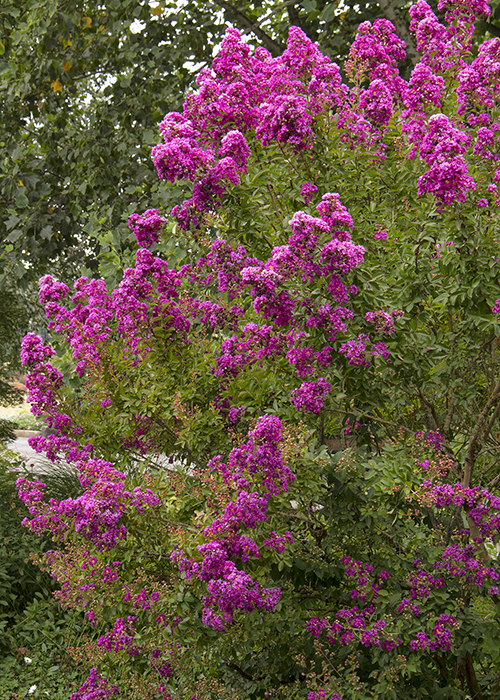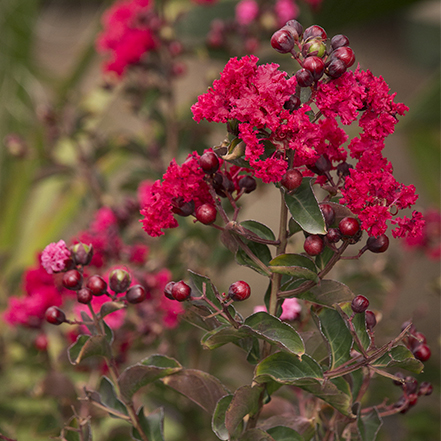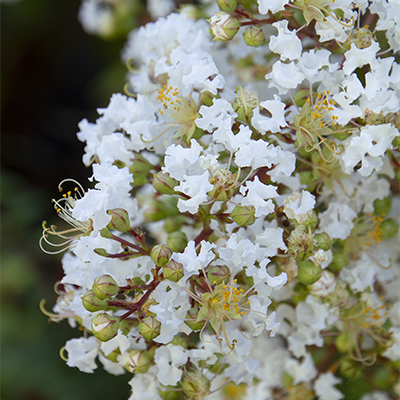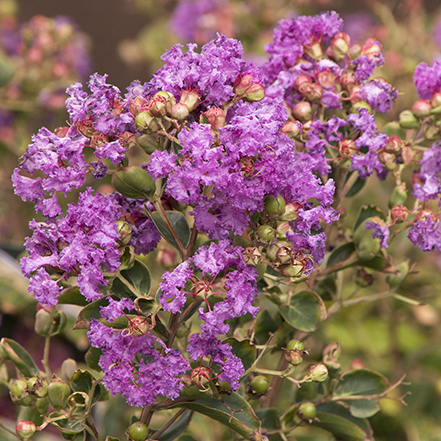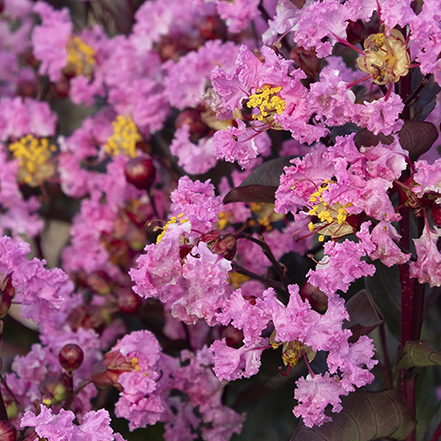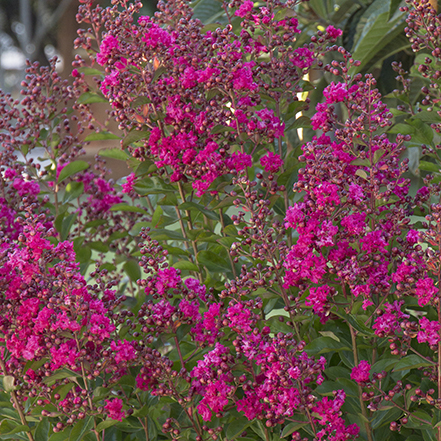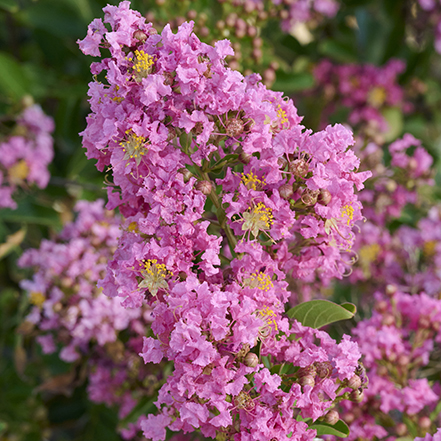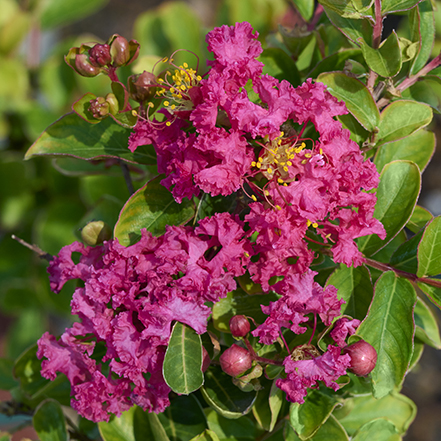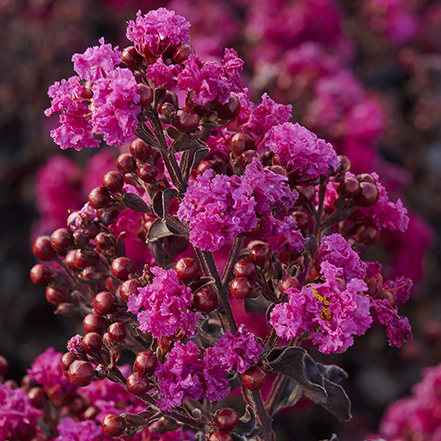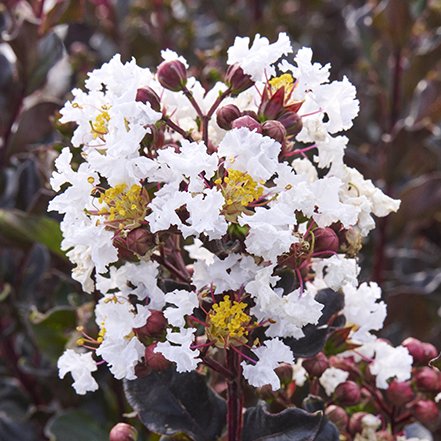Beloved for their showy summer blooms and multi-season appeal, crape myrtles are an ornamental tree or shrub that thrives in mild climates and sunny landscapes. When properly sited and cared for, these plants can live for decades, lighting up your yard with vibrant, colorful flowers summer after summer.
To enjoy the enduring appeal of these trees, it's important to follow best practices for crape myrtle care, from planting and pruning to troubleshooting common issues. Follow this care regimen for healthy crape myrtles that provide ample floral displays, fall foliage, and striking winter bark.
Crape Myrtle Shrub vs. Tree
(Above) Catawba Crape Myrtle is a small crape myrtle tree that only reaches 15' tall.
What's the difference between a Crape Myrtle tree and a bush?
Where the line is drawn between a bush and a tree can get a little hazy with crape myrtles. Some crape myrtles grow to only 3 feet tall, while others reach 20 feet or more, and you can find a variety of almost any size in between.
Many of the largest varieties grow upright and develop a spreading crown, creating a lovely tree. Crape myrtles naturally grow with multiple trunks. Training it into a single trunk is possible but must be started when the plant is very young. Because of this, if you want your tree to have a single trunk, you need to buy it as such. A multi-stemmed tree should not be converted to a single trunk; it will be unattractive and damaging to the plant.
Mid-sized shrubs can be pruned into a multi-stemmed tree form to show off their attractive bark by removing the lowest branches as the plant grows. This is a great way to create a showy focal point in the landscape. Alternatively, the shrub can be left to grow in its natural bushy form to provide privacy or screen an unattractive view.
Where and How to Plant Crape Myrtles
Crape Myrtle Spacing
The first step in planting crape myrtles is choosing a spot that allows for plenty of space for the mature plant. It's common for crape myrtles to reach a height of 15-20 feet, while compact varieties, like Summerlasting™ Crape Myrtles, are much smaller.
Give crape myrtles adequate room to reach their expected mature size, and place them where they won't obstruct walkways or utility lines as they grow. Position them 10-15 feet from foundations, driveways, and decks to allow for future spread and prevent drips from flowers.
Crape Myrtle Light Needs
Crape myrtles love the sun, so it's equally as important to ensure your plant gets plenty of light; ideally, at least 6 hours of direct sun per day. Your planting location should receive sunlight for most of the day. A sunny location is rewarded with lots of colorful blooms; too much shade and you won't get many blooms.
Crape Myrtle Soil and Moisture Needs
Crape myrtles grow in a wide range of soils and have some drought tolerance, but they prefer moist, well-drained soil.
How to Plant Crape Myrtles
When it comes time to plant, thoroughly water the potted crape myrtle before digging. Then, dig a hole three times wider than the root ball but no deeper. Gently remove the tree from its container and tease apart any encircling roots before placing it in the hole. Face the most attractive side of the tree away from the prevailing wind. The top of the root ball should be level with the surrounding soil.
Refill the hole with native soil, firmly packing it down to stabilize the tree while eliminating air pockets. Create a shallow water basin around the base to help direct irrigation. Water thoroughly after planting, and top dress with 2-3 inches of organic mulch, like pine fines, taking care to avoid direct contact with the trunk.
First Year Care
The first year after planting is critical for establishing newly planted crape myrtles. Regular irrigation is vital to developing a healthy root system. However, crape myrtles don't like to sit in soggy soil. To ensure proper watering, monitor the moisture of the soil at the root ball. Allow the top two or three inches of soil to dry before watering deeply. Target the soil, not foliage, when watering to encourage deep roots.
Stake a tree for its first year to prevent wind damage to shallow roots, but tie the trunk loosely to allow some sway. Remove the stake after 12 months once the root system is more developed. This is only necessary for crape myrtles trained into tree forms, and is particularly helpful for those with a single trunk planted in a windy area.
Hold off on heavy pruning for a year after planting to allow the tree to focus its energy on root establishment. If your soil is sandy or poor, apply a balanced liquid fertilizer monthly for the first summer. In subsequent years, an early spring dressing or slow-release fertilizer should be sufficient.
Mulch each spring to conserve moisture and suppress weeds.
How to Prune Crape Myrtles
(Above) Zuni Crape Myrtle is a small crape myrtle tree that reaches up to 12' tall and 10' wide.
Pruning After the First Year
Pruning your crape myrtle is often optional. If you choose to prune your shrub or tree, the ideal time to prune crape myrtles is late winter before spring growth begins. Never prune in fall or early winter, as new growth could be damaged by cold. The seed heads can stay on the plant all year, and you'll still get colorful blooming in the current year.
If you decide to prune, keep these tips in mind:
- Use hand pruners or loppers to remove suckers, which are dead or damaged branches at the truck. As a general rule, remove lower limbs thinner than a pencil diameter.
- When the plant is young, you can prune the top of the branches. Shorten the top branches by 2-3 feet to control the height if needed.
- Always cut back to just above an outward-facing bud or branch.
- Avoid severe chopping, as this will destroy the natural form of your crape myrtle.
- Remove spent flowers through the summer to encourage reblooming.
- Over time, as you prune from season to season, you can gradually lift lower branches to show off the decorative trunk pattern.
How to Fertilize Crape Myrtles
Mature crape myrtles typically only need light fertilization, as excessive feeding can cause leafy growth instead of flowers. Apply a balanced fertilizer or compost in early spring before new growth emerges. Established crape myrtles in fertile soil probably do not need extra fertilization. If you are unsure about the health of your soil, a soil test can help you discover is your soil has any nutrient deficiencies.
Remember to always water your crape myrtles after fertilizing.
Stop fertilizing in the late fall and water less often. This gives crape myrtles the chance to harden off, which prepares them for winter dormancy. You can think of the hardening process like "toughening up" your plant to withstand the colder and drier winter climate.
How to Water Crape Myrtles
During the first year of having your crape myrtle, you'll need to water it more often. Ensure you soak the tree's root system thoroughly, and be careful not to overwater. It's important to let the soil dry out a bit between waterings.
Crape myrtles should receive one inch of water per week, which may be taken care of by Mother Nature. If you're experiencing a dry period, you'll need to water your plant. The period when your crape myrtle will need the most water is just before, during, and after the blossom period (about six weeks total).
Be vigilant about watering young crape myrtles, especially during dry spells. Once the plant reaches full maturity (usually after five years), it will be naturally drought-resistant.
Winter Care for Crape Myrtles
First, be sure to plant a crape myrtle that is hardy in your Hardiness Zone. For young crape myrtles (1 year or less), if an unusually cold weather front is looming, it's best to wrap them in burlap around the branches for extra protection and insulation. Remove the wrapping in early spring.
Crape myrtles (both young and mature) will also benefit from extra mulch in the winter. Increase the mulch over the root zone up to 6 inches in the winter, and remove extra mulch come spring.
Also, remember to avoid late-reason pruning and remove dead branches in the early spring after the danger of frost has passed. With the proper care, your crape myrtle can withstand the cold and be ready to provide color and bloom come spring.
Common Crape Myrtle Care Questions
How can I get my crape myrtle to bloom more?
Proper pruning in late winter encourages prolific flowering. Ensure the tree gets full sun — at least 6 hours of direct daily sun. Removing spent blooms in summer will often promote reblooming. Also, avoid overfertilizing, which leads to excessive leafy growth instead of flowers.
How can I get my overgrown crape myrtle to flower again?
Rejuvenate overgrown, underperforming crape myrtles with judicious renewal pruning over successive years. Thin and shape the canopy, removing up to a third of the oldest branches annually. Fertilize lightly in spring and irrigate during summer dry spells to stimulate regrowth.
When is the best time to prune my crape myrtles?
The optimal time to prune crape myrtles is late winter before spring growth begins. Avoid fall or early winter pruning, as it can lead to cold damage to new growth. Mid-summer pruning removes spent blooms for reblooming.
How cold hardy are crape myrtles?
Crape myrtles are typically hardy in zones 7-9, though their cold tolerance varies by variety. Protect young or marginally hardy trees from winter damage by mulching and wrapping trunks once dormant. If you live in a region with cold winters, look for cold-hardy varieties of this plant.
Best Crape Myrtle Trees
Dynamite®
Crape Myrtle
An attractive ornamental shrub or small tree with smooth, peeling bark. Showy, ruffled, fiery red summer flowers are followed by vibrant orange-red fall foliage. An excellent choice as a specimen plant, or en masse for an explosion of color in the landscape and year-round interest. Full sun. Up to 20' tall, 15' wide. Zones 6-10.
Natchez
Crape Myrtle
A large shrub or small tree with smooth, dark, cinnamon-brown, exfoliating bark. Glossy dark green leaves turn vibrant orange-red in fall. Panicles of pure white, soft-textured flowers bloom all summer. Makes an excellent specimen, accent, or group planting. Full sun. Up to 20' tall and wide. Zones 6-9.
Catawba
Crape Myrtle
Displays large, long-lasting clusters of dark purple crepe-like flowers. Handsome foliage has a bronze hue in spring, is bright green in summer, and turns vibrant orange-red in autumn. Mildew resistant. Develops a nicely shaped naturally rounded dome as it matures. Full sun. Up to 15' tall, 14' wide. Zones 7-9.
Best Large Crape Myrtle Shrubs
Double Dynamite®
Crape Myrtle
Get two explosions of color throughout summer on this reblooming crape myrtle with colorful foliage that emerges deep purple and matures to a dark purple-green, and a profusion of large, sterile flower clusters that emerge bright pink and age to intense cherry red. Resists mildew, and is heat tolerant. An ideal upright shrub for landscape or container. Full sun. Up to 10' tall, 12' wide. Zones 7-10.
Tonto
Crape Myrtle
Large clusters of soft-textured fuchsia-red blooms on a semi-dwarf, multi-stemmed shrub. Foliage turns a luscious orange-red in fall for exquisite cool season color. Smooth, colorful peeling bark adds year-round interest. Resists mildew, and is heat and drought-tolerant. Ideal as a landscape accent or container specimen. Full sun. Up to 8' tall and wide. Zones 6-9.
Pecos
Crape Myrtle
A remarkable crape myrtle that features large clear pink flower trusses, improved hardiness over other varieties, excellent mildew resistance, and attractive exfoliating bark. The glossy dark green foliage develops a beautiful fall color that ranges from orange-red to a rich maroon. An excellent border plant or landscape accent.Full sun. Up to 8' tall, 6' wide. Zones 6-9.
Best Compact Crape Myrtle Shrubs
Petite Embers™
Crape Myrtle
A dwarf crape myrtle with a small, shrubby form and upright branching topped by a profusion of bubblegum-pink-colored crepe-like flower clusters in the heat of summer. A very useful size for smaller landscapes. Excellent massed in single-color plantings or used as an individual accent. Adapts well to containers. Full sun. Up to 5' tall, 4' wide. Zones 7-9.
Summerlasting™ Raspberry
Crape Myrtle
Why wait for colorful crape myrtle blooms' Bright pink flowers appear weeks earlier than other dark foliage varieties, and rebloom without the need for deadheading, filling your summer with color that pops in front of black foliage. This compact, dwarf variety is perfect for smaller landscapes, or plant en masse for a dramatic statement. Full sun. Up to 3' tall and wide. Zones 7-10.
Summerlasting™ Coconut
Crape Myrtle
Fill your summer with the dramatic contrast of pure white blooms on black foliage. Flowers hold over an exceptionally long season and will rebloom if spent flowers are removed. This compact, dwarf variety is perfect for smaller landscapes, or plant en masse for a dramatic statement. Full sun. Up to 3' tall and wide. Zones 7-10.
Get More Plant Care Tips and Guides
- Sign up for the Grow Beautifully Newsletter. You'll get gardening tips, design advice, free digital guides, and live webinar invites. Plus, new, exclusive plant information delivered straight to your inbox twice a month.
- Camellia Care Guide
- Hibiscus Care Guide
- Conifer Care Guide
- Boxwood Winter Care
- Azalea Care Guide
- Hydrangea Care Guide
- Top 10 Tips for Planting in Summer
- How to put Hydrangeas to Bed for Winter
- Our Top 10 Gardening Tips
- Guide to Pruning Flowering Shrubs
- How and When to Prune Hydrangeas
- Pruning Ornamental Grasses
- How and When to Prune Lavender
- Check out the "Garden Tips" section of the blog. Here there are care guides and garden tips on a wide array of plants.





